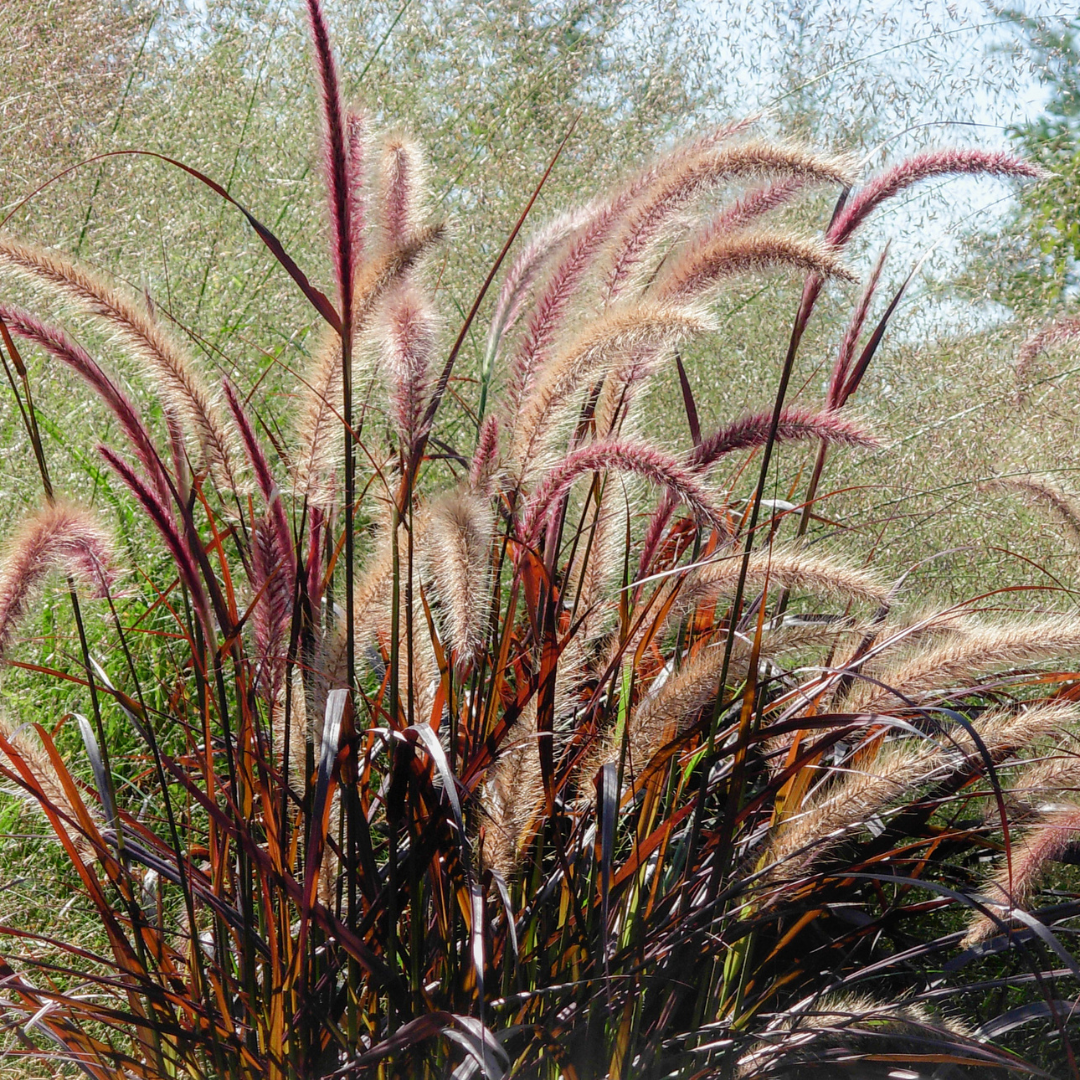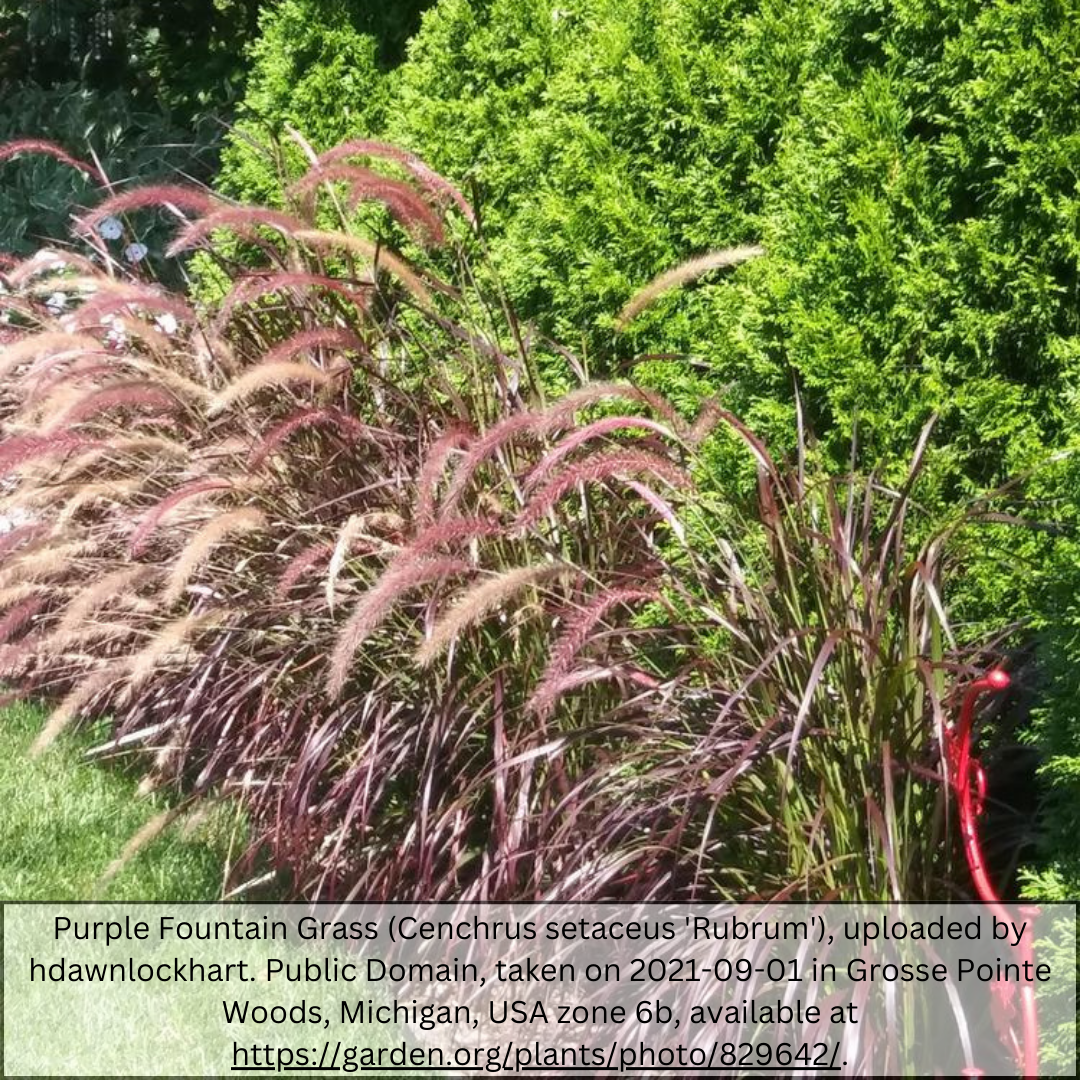My Store
Purple Fountain Grass
Purple Fountain Grass
Couldn't load pickup availability
Plant Type: ornamental grass
Plant Height: 3-5 feet
Spread: 2-4 feet
Flower Color: burgundy-purple plumes
Sun Exposure: Full Sun
Purple Fountain Grass (Pennisetum setaceum 'Rubrum') – Dramatic, Drought-Tolerant Ornamental Grass for Arizona Gardens
Add color, movement, and texture to your Phoenix Valley garden with Purple Fountain Grass, a striking ornamental grass known for its burgundy-purple foliage and elegant flower plumes. Scientifically referred to as Pennisetum setaceum 'Rubrum,' this versatile grass is native to East Africa, the Middle East, and Southwest Asia, making it a natural fit for warm, arid climates. Perfect for xeriscaping, mixed borders, and container plantings, Purple Fountain Grass brings year-round interest to your Arizona landscape.
Key Features of Purple Fountain Grass
Growing up to 3 to 5 feet in height and spread, Purple Fountain Grass forms an elegant, fountain-like mound of arching, deep purple leaves that adds dramatic color and texture to garden beds. In summer, this ornamental grass produces tall, feathery flower plumes that emerge in shades of purple and fade to soft tan, providing a stunning display that adds movement to the landscape. The flower plumes can be used in fresh or dried floral arrangements, making this plant as versatile indoors as it is outdoors.
Adapted to full sun, Purple Fountain Grass thrives in well-draining soil and is notably drought-tolerant once established, making it an excellent choice for Phoenix Valley’s dry climate. While typically grown as a perennial in warm regions like Arizona, Purple Fountain Grass may be treated as an annual in cooler climates where frost is a concern.
A Water-Wise Choice for Phoenix Valley Gardens
Purple Fountain Grass’s drought tolerance and low water needs make it a valuable addition to Arizona’s water-conscious landscapes. This hardy grass provides bold color and lush foliage with little watering, promoting sustainable gardening practices in the Phoenix Valley.
Versatile Uses for Purple Fountain Grass in Phoenix Valley Landscaping
-
Specimen Plant and Focal Point: With its dramatic color and graceful form, Purple Fountain Grass makes a stunning specimen plant, adding height and visual impact to garden beds and open spaces.
-
Mass Plantings and Borders: Its bold, arching foliage and showy plumes create a striking effect when planted in masses or used in mixed borders, enhancing depth and texture in the landscape.
-
Container Gardening for Patios and Balconies: Purple Fountain Grass’s compact size and vibrant color make it a fantastic choice for large containers, where it can add height and drama to patios, balconies, and entryways.
-
Xeriscaping and Drought-Tolerant Gardens: Adapted to dry conditions, Purple Fountain Grass is a natural choice for xeriscapes and water-wise gardens, blending beautifully with succulents and other low-water plants.
Care Tips for Growing Purple Fountain Grass in Phoenix Valley
Plant Purple Fountain Grass in a sunny location with well-draining soil to encourage healthy growth and vibrant color. Water regularly during the first growing season to establish roots; afterward, it requires minimal supplemental watering. In Arizona’s warm climate, this grass can thrive as a perennial, though in frost-prone areas, it may be treated as an annual. Light pruning in early spring will help maintain its shape and encourage fresh growth. Known for its resilience, Purple Fountain Grass is a low-maintenance choice, ideal for busy gardeners looking for bold, easy-care plants.
Why Purple Fountain Grass is Perfect for Arizona Landscapes
Purple Fountain Grass offers Phoenix Valley gardeners a vibrant, drought-tolerant grass that provides year-round interest and beauty with minimal care. Its tolerance for heat, rich color, and elegant flower plumes make it a versatile addition to beds, borders, and container plantings. Whether used as a specimen plant, in mass plantings, or for height in patio containers, Purple Fountain Grass combines eye-catching beauty with durability, enhancing Arizona gardens with its lively appearance and adaptability. For a low-maintenance grass that thrives in warm climates, Purple Fountain Grass is an exceptional choice.
Three Timbers Installation Guide (Feel Free to Follow): Purple Fountain Grass
Planting Guide:
- Location: Full sun (at least 6 hours of direct sunlight for optimal growth and blooming)
- Soil: Well-drained, sandy or loamy soil (slightly acidic to neutral soil preferred)
- Spacing: Space plants 2-3 feet apart to allow for spreading growth and air circulation
- Planting Depth: Plant at the same depth as the root ball, ensuring the top of the root ball is level with the surrounding soil surface
- Support: Purple Fountain Grass is a clumping grass that requires no staking
Watering Guide:
Watering After Planting:
- Initial Watering: Water thoroughly immediately after planting to saturate the root ball and surrounding soil
- Frequency: Water every 3-4 days for the first 2-3 weeks to help establish the root system
- Watering Amount: Provide 1-1.5 inches of water per session for deep watering
When is the Plant Established?
- Timeframe: Purple Fountain Grass is considered established after 2-3 months when the roots have spread into the surrounding soil
Watering Once Established:
- Summer: Water every 7-10 days during the hotter months. If temperatures exceed 100°F, increase watering to every 5-7 days. Provide 1.5-2 inches of water per session.
- Winter: Water every 3-4 weeks during the cooler months, depending on rainfall.
Drip Irrigation Setup:
- Placement of Emitters: Place the drip emitters 12-18 inches away from the base of the plant for even watering
- Flow Rate: Use emitters with a flow rate of 1-2 gallons per hour
- Number of Emitters: 1 emitter per plant for even watering distribution
- Adjusting Frequency: In summer, increase watering frequency to every 5-7 days. In winter, reduce to every 3-4 weeks
Share
















